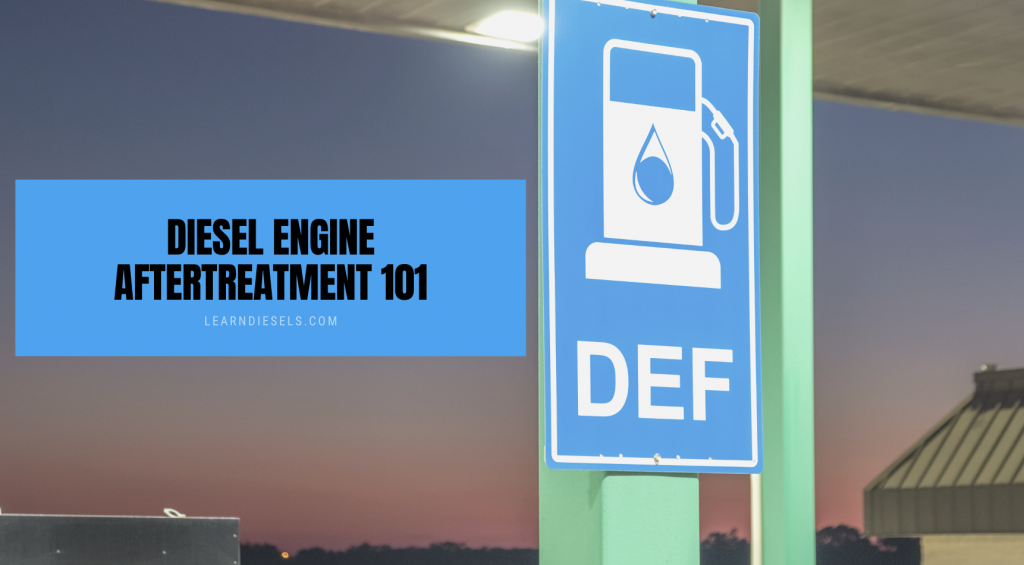Diesel engines produce harmful emissions that pollute the air and pose risks to your health. To mitigate these concerns, diesel aftertreatment systems were developed. Today, they play a key role in reducing emissions and ensuring compliance with engine emission standards.
In this article, I will walk you through the world of diesel engine aftertreatment. By the end, you will have a proper understanding of diesel engine emissions and much more.

Key Takeaways:
- Diesel Aftertreatment is used to reduce harmful vehicle emissions.
- Selective Catalytic Reduction and Diesel Exhaust Fluid work together to reduce Nitrogen Oxide.
- Diesel Particulate Filters reduce Particulate Matter emissions, primarily Soot and Ash.
- Exhaust Gas Recirculation helps reduce the formation of nitrogen Oxide.
Introduction to Diesel Engine Aftertreatment
Diesel engine aftertreatments are forms of emissions control designed to mitigate and reduce the environmental harm produced by diesel engine exhaust.
Diesel aftertreatment may work through filtration, chemical reactions, and catalysis. These controls are used downstream from the engine, designed to reduce or eliminate dangerous emissions before they enter the atmosphere.
Common forms of diesel engine aftertreatment are:
- Diesel particulate filters (DPF)
- Selective catalytic reduction (SCR)
- Exhaust Gas Recirculation (EGR)
These emission controls are not voluntary; they are set and regulated by the United States Environmental Protection Agency.
Common Diesel Engine Emissions
Diesel engine emissions contain a mixture of pollutants. Some of these include:
Nitrogen Oxides (NOx): These gases are produced from high combustion temperatures within diesel engines. They contribute significantly to smog formation and acid rain, both of which have detrimental effects on our environment.
Particulates or Soot: Diesel engines release these tiny particles into the air we breathe — posing significant health risks as they can penetrate deep into our lungs when inhaled.
Carbon Monoxide (CO): This gas is a product of incomplete combustion in diesel engines. It can cause headaches, dizziness, weakness, nausea, and even death at high levels due to its ability to displace oxygen in the blood.
Hydrocarbons (HC): These compounds comprise hydrogen and carbon atoms. They react with nitrogen oxides in sunlight to create ground-level ozone or smog – causing respiratory problems among other health issues.
The Science Behind Diesel Aftertreatment
Pollution control technology and diesel aftertreatment are just as complicated as they sound. Your diesel car or truck is performing a series of complex chemical reactions while you’re just sitting in rush-hour traffic!
I’m going to explain some key concepts you must understand to grasp how the diesel aftertreatment systems work.
Redox – Reduction-Oxidation
Redox is a chemical reaction where one substance transfers electrons to another substance. The term “reduction” refers to the gain of electrons by a molecule, while the term “oxidation” refers to the loss of electrons.
But why do we care about gaining and losing electrons (redox)? Because Redox is used in a common diesel aftertreatment method called “Selective Catalytic Reduction (SCR)” to convert Nitrogen Oxide into harmless Nitrogen Gas (N2) and Water.
Catalysts
Several common diesel aftertreatment processes involve the use of catalysts.
Catalysts are substances used to facilitate chemical reactions. They lower the activation energy needed for chemical reactions to occur, and most importantly, the catalysts are not consumed in the process.
Common materials used as catalysts in diesel aftertreatment are precious metals, base metals, and mixed metals.
In diesel aftertreatment, catalysts are important because they help facilitate the transfer of electrons. For example, as diesel exhaust gases pass over a catalytic surface, the hydrocarbons and carbon monoxide experience oxidation which transforms them into harmless carbon dioxide and water.
Diesel Exhaust Fluid (DEF)
Diesel exhaust fluid is sometimes also known as “AdBlue”. It is a non-toxic, non-flammable liquid composed of one-third urea and two-thirds deionized water.
Ordinarily, your diesel exhaust fluid will be housed in a container under the hood of your vehicle.
“Urea Definition”: Urea is a chemical compound consisting of carbon atoms bonded to nitrogen, oxygen, and hydrogen atoms. It is organic and naturally produced in the urine of mammals.
When the urea is introduced to diesel exhaust along with a catalyst, it forms a “redox” reaction with nitrogen oxide, completing the transformation of NOx into nitrogen gas and water.
Particulate Filters
Particulate filters are used in diesel aftertreatment systems to capture particulate matter such as soot and ash before they are released into the atmosphere.
Particulate filters often have the ability to filter exhaust down to a range of 2 to 10 microns. For reference, one micron is equal to 1 millionth of a meter, or 0.001 millimeters (mm).
Diesel Exhaust Aftertreatment Systems
Now that we have an understanding of the science behind common aftertreatment methods, let’s have a look at the diesel aftertreatment systems installed on common vehicles.

Diesel Oxidizing Catalyst (DOC)
After exhaust first leaves the engine, its first stop is usually through the diesel oxidizing catalyst.
The purpose of the DOC is to facilitate a chemical reaction that converts carbon monoxide and hydrocarbons into harmless carbon dioxide and water vapor before it is released into the atmosphere.
The DOC is able to perform this conversion by oxidizing the CO and HC using heat and a catalyst. The heat is sourced from the hot exhaust itself. The catalyst is made from precious metals such as platinum (Pt) and palladium (Pd).
Disadvantages to the Diesel Oxidizing Catalyst System
Because the DOC system relies on heat from the exhaust system itself, it becomes much less effective in colder climates and at lower operating temperatures.
Additionally, because the DOC system is often located upstream of the diesel particulate filter, it can accumulate soot over time, reducing its effectiveness.
Lastly, the catalyst within the DOC system tends to degrade over time due to contamination and thermal cycling. This degradation leads to an increase in emissions released into the atmosphere.
Selective Catalytic Reduction and Diesel Exhaust Fluid
The Selective Catalytic Reduction systems (SCR) and Diesel Exhaust Fluid work together to reduce or eliminate nitrogen oxide from being released into the atmosphere.
The reason for the name “selective” in “selective catalytic reduction” is because the system is designed to only target nitrogen oxide, while leaving other components of the exhaust unaffected.
Diesel exhaust fluid is injected directly into the exhaust pipe upstream of the nitrogen oxide catalyst.
The diesel exhaust fluid, consisting of urea and water, creates the needed “redox” reaction with the diesel exhaust when in the presence of the catalyst, which reduces the amount of nitrogen oxide released into the atmosphere.
This SCR system can achieve up to 90% efficiency in converting nitrogen oxide into nitrogen gas and water when operated under ideal conditions.
SCR and DEF Disadvantages
SCR systems usually experience a reduction in efficiency at cold temperatures. Therefore, they are often not considered effective until the exhaust gas is at operating temperature.
An SCR system consumes a lot of space in a vehicle and is expensive to manufacture and maintain.
The urea in diesel exhaust fluid can naturally decompose after some time.
Diesel exhaust fluid is a consumable and requires regular refilling. On some vehicles, running out of DEF may put the vehicle into a derated mode, reducing the power and performance of the vehicle until the DEF is refilled.
Diesel Particulate Filters
The purpose of diesel particulate filters is to trap and eliminate particulate matter from diesel exhaust before it enters the atmosphere.
Particulate filters are normally placed upstream of the SCR and DEF injection to protect these components.
Diesel particulate filters are commonly made from ceramic fibers or cordierite.
DPF Regeneration
Over time, diesel particulate filters accumulate particulate matter which restricts the flow of exhaust gas through them. The restricted flow of exhaust gases leads to back pressure, which hinders the performance of the vehicle.
In order to combat this, DPFs will have a “regeneration” method.
Regeneration is achieved by heating the exhaust or filter to a temperature sufficient to oxidize and burn off accumulated soot in the filter.
Ordinarily, this is achieved through “passive regeneration” where the exhaust gases are hot enough to naturally burn off soot during highway or high-load operation.
When a vehicle doesn’t achieve sufficient temperatures for passive regeneration, an “active regeneration” method can be used. This involves heating the filter through electrical methods or injecting raw fuel into the exhaust pipe to achieve sufficient heating to oxidize and burn off soot.
DPF Disadvantages
The particulate matter that the DPF is capturing contains soot and ash.
As we have seen, the soot in a filter can be burnt off through “regeneration” methods. However, ash contains non-combustible materials such as metal oxides and sulfates and therefore cannot be burnt off.
Because of this, DPFs must be periodically cleaned and replaced, resulting in higher maintenance costs.
Additionally, DPFs increase engine backpressure. Any restriction to gas flow in an engine reduces its performance.
Exhaust Gas Recirculation (EGR)
Exhaust gas recirculation is a vehicle emissions control system used in both diesel engines and petroleum engines.
The purpose of exhaust gas recirculation is to reduce the formation of nitrogen oxides.
It’s important to note that while the SCR system helps to remove already formed NOx gases, the EGR system helps to prevent them from forming in the first place.
The EGR system achieves this by recirculating a portion of the engine’s exhaust gases back to the combustion chamber.
The addition of exhaust gas into the combustion chamber reduces the amount of oxygen available in the combustion process. In effect, the reduced oxygen lowers the combustion temperature.
This reduced temperature is important because nitrogen oxide is formed in the combustion process when Nitrogen and Oxygen molecules react at high temperatures. In fact, NOx production increases exponentially as temperature increases, making temperature control a key factor in reducing emissions.
EGR Disadvantages
- By reducing the amount of oxygen available for combustion, the EGR system reduces the power and performance available to a vehicle.
- By introducing exhaust gas into the combustion chamber, the EGR system may cause soot deposits on glow plugs, intake valves, cylinder heads, turbochargers etc.
Diesel Engine Aftertreatment Maintenance – Avoiding Downtime and Extra Expenses
Diesel aftertreatment systems do require maintenance and regular servicing. Luckily, some of the regular aftertreatment maintenance tasks can be completed by the “do-it-yourself” mechanic and are generally low cost.
Regular “DIY” aftertreatment maintenance items include:
- Cleaning and replacing DPF filters
- DEF refilling
- Systems inspection; Checking SCR, DPF, and EGR for corrosion, damage, and leaks.
Regular aftertreatment maintenance that you’ll need a mechanic for:
- Sensor diagnostics; recalibrating and/or replacing sensors used in aftertreatment
- Software updates; many modern aftertreatment systems utilize electronic control units
- Emissions testing; many states require regular emissions testing to ensure compliance
Clean Air Regulations and Legislation
In the United States, the Environmental Protection Agency (EPA) is responsible for enforcing the Clean Air Act (CAA).
The Clean Air Act is a federal law that governs air pollution in the United States.
One way in which the Clean Air Act attempts to control air pollution is by setting and regulating emission standards for diesel engines. These standards set limits on how much nitrogen oxide, particulate matter, and carbon monoxide a diesel engine can emit.
In order to comply with these stringent emission standards, diesel manufacturers must rely on and implement technology such as particulate filters, selective catalytic reduction systems, and exhaust gas recirculation as discussed above.
Compliance with the Clean Air Act is mandatory.
Conclusion
In conclusion, diesel aftertreatment technologies play a pivotal role in mitigating the environmental impact of diesel engines by reducing harmful emissions and improving air quality.
From selective catalytic reduction (SCR) systems to diesel particulate filters (DPFs) and exhaust gas recirculation (EGR) systems, these technologies offer effective solutions for controlling nitrogen oxide (NOx), particulate matter (PM), and other pollutants.
